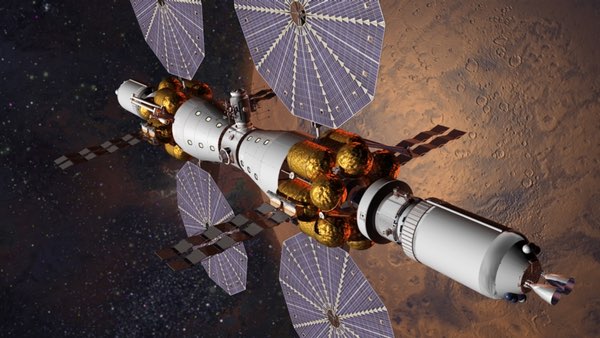Is the Moon a necessary step on the path to Mars?by Chris Carberry and Rick Zucker
|
| Do we actually need to land humans on the surface of the Moon before we go on to Mars? |
Over the past few years, the concept of human missions to Mars has gained momentum as the primary goal of the US space program, not only in the executive and legislative branches of government but also among numerous commercial players as well as in the press and entertainment communities. In fact, humans-to-Mars has been the cornerstone of official US space policy for over a decade, as set forth in the NASA Authorization Acts of 2005, 2008, and 2010. Indeed, in the proposed NASA Authorization Act of 2015, passed by the House of Representatives, stated in Section 201(a), “It is the policy of the United States that the goal of the Administration’s exploration program shall be to successfully conduct a crewed mission to the surface of Mars to begin human exploration of that planet.”
In contrast, however, lunar proponents have instead been aggressively advocating a return to the Moon. Some of this has been encouraged by the “Lunar Village” concept that ESA director general Jan Wörner has proposed. Others clearly hope that they can influence the next administration to focus on returning to the lunar surface rather than exploring Mars. Some have even gone so far as to attempt to advance human lunar surface operations by asserting that humans traveling to Mars cannot be achieved without those extensive lunar operations.
It is true that most current Mars architecture plans do utilize cislunar space as an essential stepping-stone to Mars. But, do we actually need to land humans on the surface of the Moon before we go on to Mars?
Proponents for the Moon have suggested that testing landing hardware and life support systems, as well as building fuel depots on the lunar surface, are necessary before sending humans to Mars. However, most mission architects and designers believe that while some of these steps may have some value for Mars exploration, they are not required to land humans on Mars. For example, landing on the Moon, which has no atmosphere, and landing on Mars, which does, require vastly different engineering solutions. In the case of fuel depots and government-funded Moon bases purported to enable Mars exploration, the diversion of human and financial resources would lead to decades-long delays in a subsequent human mission to Mars.
Further, as stated in the Report of the Second Mars Affordability and Sustainability Workshop (October 2014), “The scientific goals for lunar exploration are compelling (i.e., see the 2011 NRC Planetary Decadal Survey and 2007 Scientific Context for Exploration of the Moon). However, the technical capabilities required for human lunar surface operations are of limited applicability to human Mars exploration”.
This is not to say that there is little value in a human presence on the lunar surface, which should be justified in its own right. Claiming extensive, costly lunar surface operations as a required stepping stone for human missions to Mars, however, is not consistent with the very different engineering and scientific requirements needed to achieve each goal.
| Congress and the next administration must not change paths once again by redirecting the human space program. The goal of humans on Mars is a compelling one and has long-standing public and bipartisan support. |
While there have been discussions overseas about the proposed “Lunar Village”, it remains to be seen if the proponents of such a concept have the mission architecture plans or support, and most importantly, the willingness to actually commit the necessary funding, to move this plan past the “storyboard” stage of planning. Various commercial entities have also recently expressed interest in participating in lunar activities as well. If they can devise realistic business plans for their ventures, the Moon could be an attractive destination for commercial activities. In any case, can the international and commercial lunar advocates devise a plan that could land humans on the Moon in the 2020s but not delay our current plans to land humans on Mars in the 2030s?
One methodology that was suggested by NASA administrator Charles Bolden would be for NASA to provide a ride on the Space Launch System, as well as other capabilities, if other agencies produced a lunar landing craft as well as surface operations capabilities. So far as we know, however, such a cost-sharing partnership has never been entered into, and budgets outside the US remain very constrained, with little evidence that this will change within the next few years. Offers of this kind by NASA could be a model to further our relationships with our international partners, but such partnerships must be true partnerships, especially when it comes to funding such ventures.
That said, we should not let lunar surface activities delay plans to land humans on Mars in the early 2030s. Without question, current Mars plans need to be more clearly defined, but support for humans to Mars has been and remains extremely strong. According to the recently released National Opinion Poll on Mars, 64 percent of Americans support human missions to Mars. As shown in the 2013 Mars Generation Survey, support is even stronger when Americans are made aware that the NASA budget accounts for less than half of one percent of the federal budget and that Mars missions will not cost even close to a $1 trillion that some pundits and cynics have claimed.
Congress and the next administration must not change paths once again by redirecting the human space program. The goal of humans on Mars is a compelling one and has long-standing public and bipartisan support. The most effective role that a new Administration and Congress can play in our space program would be to call for a clear and aggressive plan for beginning human missions to Mars no later than the early 2030s and to provide stable and sufficient funding and leadership to accomplish this goal.
